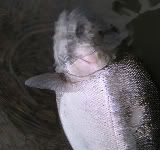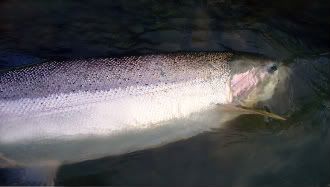I get those, too; especially when casting compact heads without sink tips. The good news is that it's a sign you're getting good acceleration throughout your casting stroke. When your cast extends fully before it his the water, the force of the abrupt stop can cause your line to recoil slightly (or kind of a lot, depending). The less inertia your line is carrying (often less weight from sink tips, etc.), the more pronounced the effects tend to be. Slowing down your casting pace can reduce the force with which your line pulls when it is fully extended, but if you're doing things right, you're probably moving pretty slowly already.
Unless you're trying to get a fast-starting greased line or skating presentation, those squiggles can be a good thing; they give you some slack for your upstream mend, which makes it easier to mend without moving your fly a lot. If you happen to be using a dead drift presentation (the horror!), those squiggles give you a lot of extra dead drift before your line needs to be mended to avoid drag.
I have little experience casting traditional Spey lines, but what experience I do have with them suggests they are a better tool for delivering unweighted presentations at varying distances. Compact heads, the way I understand them, are designed to fully load a rod with a shorter length of line on the water so big, heavy, ugly bugs and sink tips can be delivered greater distances with a shorter casting stroke that doesn't require much back cast room. I've always felt pretty okay about ugly casts, so long as they get my gear where a fish might see it, so I guess I hadn't thought much about the squiggles when they occur.
I gather from your other posts, featuring some nice, swanky gear, that you are a man who appreciates the aesthetics of Spey casting a good deal. If that's true, I can imagine why you would like to do away with the squiggles. If you get it figured out, let me know... God knows my Spey casting has plenty of room for improvement.















 Previous Topic
Previous Topic Index
Index

